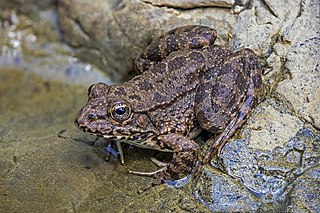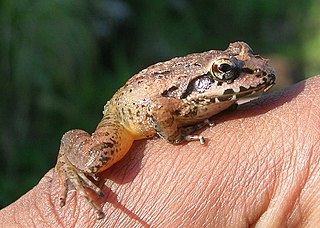
True frogs is the common name for the frog family Ranidae. They have the widest distribution of any frog family. They are abundant throughout most of the world, occurring on all continents except Antarctica. The true frogs are present in North America, northern South America, Europe, Africa, and Asia. The Asian range extends across the East Indies to New Guinea and a single species, the Australian wood frog, has spread into the far north of Australia.

Indirana is a genus of frogs in the family Ranixalidae. These frogs are endemic to the Western Ghats of India. They are sometimes known under the common name Indian frogs, whereas members of their parent family are named "leaping frogs".

Meristogenys is a genus of true frogs from Borneo. Its tadpoles are adapted to fast-flowing mountain streams and easily recognizable by their divided upper lip with ribs on the outside.

Occidozyga is a genus of frogs in the family Dicroglossidae found in southeastern Asia between eastern India, southern China, and Java. They sometimes go under the common name Java frogs or floating frogs.

Tomopterna is a genus of frogs from sub-Saharan Africa.

Microhyla, commonly known as the rice frogs or narrow-mouthed frogs, is a genus of frogs in the family Microhylidae. It consists of 42 species of diminutive frogs. Members of this genus are widespread from Ryukyu Is. in Japan, and throughout South-east Asia,.

The Petropedetidae are a family of frogs containing three genera and 12 species. They are found in sub-Saharan tropical Africa and are sometimes known under common name African torrent frogs.

Nannophrys ceylonensis, commonly known as the Sri Lanka rock frog or the Ceylon streamlined frog, is a species of frog. It used to be placed in the large frog family Ranidae but a phylogenetic study was undertaken using DNA sequences and it is now included in the family Dicroglossidae. It is endemic to Sri Lanka where its natural habitats are subtropical or tropical moist lowland forests, subtropical or tropical moist montane forests, rivers and streams.

Nannophrys guentheri is an extinct species of frog in the family Dicroglossidae. It was endemic to Sri Lanka. The species was first identified in 1882 by George Boulenger and named after the German-born British zoologist Albert Günther. It is not known where in Sri Lanka the specimens were found.

Nannophrys marmorata, commonly known as Kirtisinghe's rock frog or marbled streamlined frog, is a species of frog endemic to Sri Lanka. It used to be placed in the large frog family Ranidae but a phylogenetic study was undertaken using DNA sequences and it is now included in the family Dicroglossidae. Its natural habitats are tropical moist lowland forests, moist montane forests, rivers and streams. It is threatened by habitat loss.

Pseudophilautus variabilis, also known as the variable bush frog or variable bubble-nest frog, is a species of frog in the family Rhacophoridae. This now extinct species was endemic to Sri Lanka. Despite extensive searches in recent times, it is only known from collections prior to 1858. The reasons for its disappearance are unknown but probably involve habitat loss.
Djoko Tjahjono Iskandar is an Indonesian herpetologist who studies the amphibians of Southeast Asia and Australasia. He is a professor of biosystematics and ecology at Bandung Institute of Technology in West Java, Indonesia.

The frog family Dicroglossidae occurs in tropical and subtropical regions of Asia and Africa, with most genera and species being found in Asia. The common name of the family is fork-tongued frogs.

Craugastoridae, commonly known as fleshbelly frogs, is a family of New World direct-developing frogs. As delineated here, following the Amphibian Species of the World, it contains 129 species. They are found from the southern United States southwards to Central and South America.
Nannophrys naeyakai, also known as the Sri Lanka tribal rock-frog or Sri Lanka tribal rock frog, is a species of frogs in the family Dicroglossidae. It was described as a new species in 2007. It is endemic to Sri Lanka, where it is only known from two localities in Ampara and Monaragala Districts. N. naeyakai can be distinguished from the other Nannophrys species by the details of the tubercles on the fourth toe, sharp and narrow symphysial knob on the anterior edge of mandible and small palmar tubercles. The specific name naeyakai refers to the "naeyaka", spirits of deceased relatives in the believes of Vedda people living in the type locality area.

Pseudophilautus is a genus of shrub frogs in the family Rhacophoridae endemic to the Western Ghats of southwestern India and to Sri Lanka where the majority of the species are found. Many of them are already extinct. On the other, some species believed to be extinct have also been rediscovered.

Hylarana, commonly known as golden-backed frogs, is a genus of true frogs found in tropical Asia. It was formerly considered highly diverse, containing around 84 to 96 valid species, but taxonomic revision resulted in a major change in the contents of the genus, and today it is recognised as containing just four species.
Limnonectes jarujini is a species of frog in the family Dicroglossidae, first described from near Kaeng Krachan Dam, Thailand. It occurs in southwestern and southern, peninsular Thailand, and likely in adjacent southern Myanmar. It has been recorded from Kanchanaburi, Surat Thani, and Nakhon Si Thammarat provinces.
Limnonectes taylori is a species of frogs in the family Dicroglossidae, first described from Doi Inthanon, Thailand. It occurs in northwestern Thailand and into northern Laos and extreme east-central Myanmar, possibly into adjacent Vietnam. In Thailand, it occurs in the provinces Chiang Mai, Mae Hong Son, Lampang, Nan, and Tak.
Limnonectes bannaensis is a species of frogs in the family Dicroglossidae. It is found in southern China, Laos, Thailand and Vietnam.















